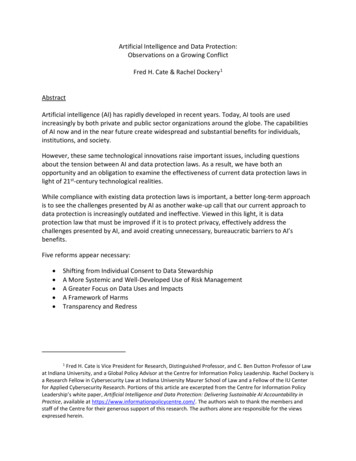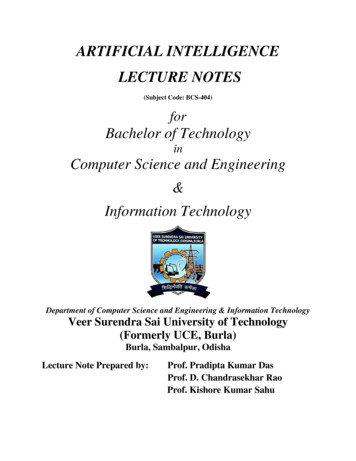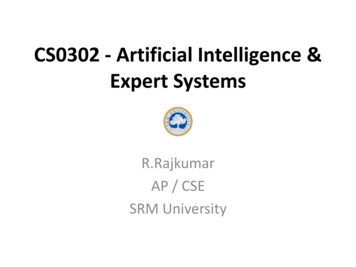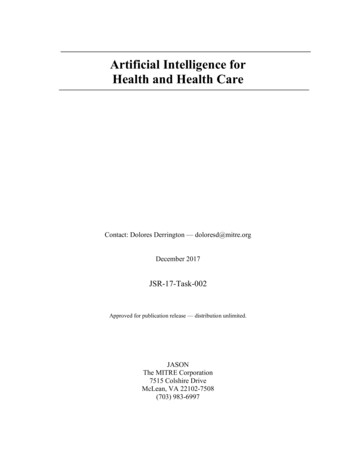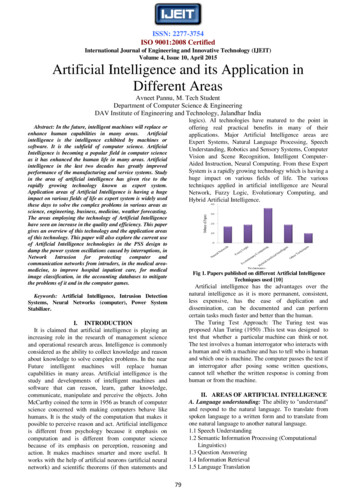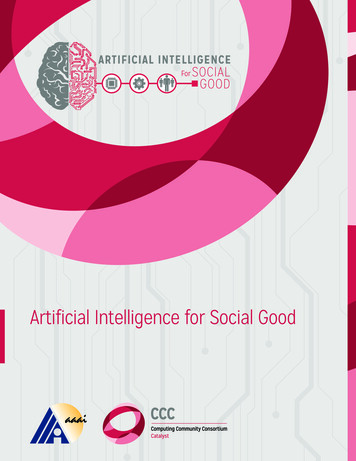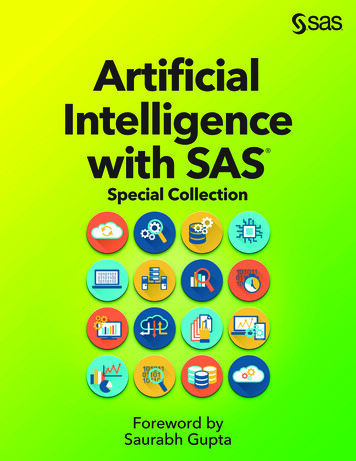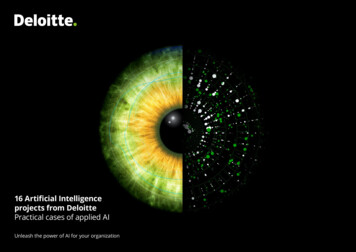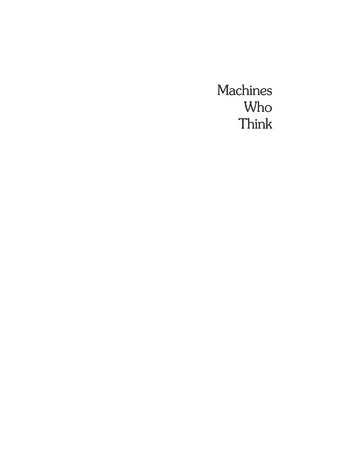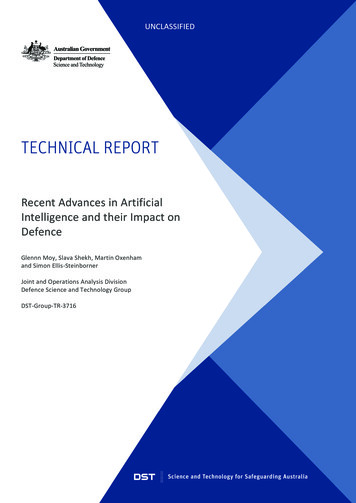
Transcription
UNCLASSIFIEDRecent Advances in ArtificialIntelligence and their Impact onDefenceGlennn Moy, Slava Shekh, Martin Oxenhamand Simon Ellis-SteinbornerJoint and Operations Analysis DivisionDefence Science and Technology GroupDST-Group-TR-3716
UNCLASSIFIEDDST-Group-TR-3716Produced byJoint and Operations Analysis DivisionDefence Science and Technology GroupDST HeadquartersDepartment of Defence F2-2-03PO Box 7931Canberra BC ACT 2610www.dst.defence.gov.auTelephone: 1300 333 362 Commonwealth of Australia 2020APPROVED FOR PUBLIC RELEASEUNCLASSIFIEDii
UNCLASSIFIEDDST-Group-TR-3716EXECUTIVE SUMMARYThere have recently been a variety of high-profile demonstrations of artificial intelligence(AI) — with significant progress being made in fields as diverse as self-driving cars, gameplaying machines and virtual assistants. In this report we discuss some of the recentbreakthroughs in AI research, and explore some of the opportunities these provide withinthe Australian Defence Force (ADF) context. This paper is intended to contribute to both thedialogue around the use of AI in the ADF, as well as to provide a useful resource for ADFmembers to enhance their education and understanding about the technologies of artificialintelligence, with a particular focus on deep learning.We begin with a high-level summary of the history of AI research, to provide some context tothe current wave of AI development. We discuss the drivers for the current growth in AIinterest and, in particular, introduce the field of deep learning and the reason for itsexponential growth and dramatic successes over the last decade. The success of deeplearning has been driven by three main catalysts: data, computation and algorithms. Theavailability of increasingly large data sets, coupled with readily available and massivecomputational resources, has enabled the development of a variety of algorithms to solvereal world problems, which only a decade ago seemed intractable.We present five significant problem-domains that have seen rapid advances during the lastdecade, and discuss the drivers for these developments and prospects for future successes.These application areas were not practical for machines prior to the recent growth in deeplearning. These are:1. image understanding2. intelligent decision making3. artificial creativity4. natural language processing5. physical automation.This list is not exhaustive, and does not reflect the breadth of the AI field, but each of theseareas has shown significant and rapid change over the last decade and are likely to seefurther successes moving forward.We also discuss the potential applications for these techniques in the military domain. Weargue that, to avoid losing its capability edge in the future, the ADF needs to invest in anumber of areas that will be critical for future AI systems. In order to embrace the potentialof AI, there will need to be a significant cultural shift in the way that military data aregenerated, captured, stored and processed. In addition, Defence needs to invest heavily inhigh performance computing. However, given the inability for Defence to replicate the dataUNCLASSIFIEDiii
UNCLASSIFIEDDST-Group-TR-3716or computational resources of the commercial AI industry as it currently exists, the ADF alsoneeds to invest in research into algorithmic improvements that maximise data andcomputational efficiency. In addition, with its legacy systems and complex environment, theADF needs to carefully consider elements of system integration to fully employ AItechnologies into the future. Finally, to ensure the ethical use of AI and contribute to theworldwide debate, the ADF needs to carefully consider social and ethical issues around theemployment of AI in military operations.UNCLASSIFIEDiv
N . 12.A BRIEF HISTORY OF ARTIFICIAL INTELLIGENCE . 32.1.Antiquity-1956 — Origins of AI . 32.2.1956-1974 — Growth in AI: Symbolic and Connectionist . 32.3.1974-1980 — The First “AI Winter” . 42.4.1980-1987 — The Rise of Expert Systems. 42.5.1987-1993 — Second AI Winter . 52.6.1993-2012 — Rapid Growth in Computation . 62.7.2012-2020 — The Rise of Deep Learning . 73.THE RISE OF DEEP LEARNING . 93.1.Data . 93.2.Computational Speed . 103.3.New Algorithms and the Perfect Storm . 114.NEW APPLICATION AREAS . 124.1.Image Understanding. 124.1.1. Current State . 124.1.2. Military Applications . 134.2.Intelligent Decision Making . 154.2.1. Current State . 154.2.2. Military Applications . 164.3.Artificial Creativity . 184.3.1. Current State . 184.3.2. Military Applications . 194.4.Natural Language Processing . 204.4.1. Current State . 204.4.2. Military Applications . 214.5.Physical Automation . 224.5.1. Current State . 224.5.2. Military Applications . 235.FUTURE OF AI AND DEEP LEARNING . 245.1.Future in Society – The next AI Winter and the hype of AI? . 245.2.Future in the ADF . 255.2.1. Data . 255.2.2. Computation . 265.2.3. Algorithms . 275.2.4. System Integration . 275.2.5. Ethics and trust . 286.CONCLUSION . 29UNCLASSIFIEDv
UNCLASSIFIEDDST-Group-TR-37167.ACKNOWLEDGEMENTS . 31REFERENCES . 32DISTRIBUTION LIST. 37UNCLASSIFIEDvi
elligence (AI)This refers to the broad class of techniques in which seeminglyintelligent behaviour is demonstrated by machines.Artificial neuralnetwork (ANN)Machine learning systems that are inspired by biological neuralnetworks. ANNs are built upon a collection of connected units (calledartificial neurons) with connections between them and an associatedweight for each connection. Each neuron takes the inputs that comeinto it and combines them using the weights and other parameters togenerate an output, which in turn feeds other neurons. Through theprocess of learning the weights, an ANN can learn to transfer complexinput data into an appropriate output for a wide range of problems.ConnectionismA theory wherein mental phenomena can be generated through theuse of interconnected networks of relatively simple computationalunits. Connectionism is the precursor to today’s artificial neural nets.Convolutionalneural network(CNN)A type of deep neural network that is most commonly applied toanalysing images. CNNs have a specially designed architecture thatmakes them comparatively easy to train, even for relatively deepnetworks. The success of CNNs for image classification tasks, in 2012,was one of the main drivers for the rapid increase in interest in deeplearning, more generally.Deep learningA form of machine learning that is based on artificial neural nets(ANNs) which involve multiple layers in a neural net, each progressivelyextracting more abstract (higher-level) features from the initial rawinput. Deep learning is the AI technique which has been mostresponsible for the rise in AI applications over the last decade. Deepneural networks are components within a number of other successfulAI techniques over the last decade.Expert systemAn early form of symbolic AI that became popular in the 1980s. Expertsystems base their decisions on a set of rules, much like a nested set of“if-then” statements, which serve to connect human-defined symbolstogether in a meaningful way. The rules are typically defined by humanexperts in the field in which the expert system performs.Machine learning(ML)A collection of techniques in which a machine learns to perform aspecific task without explicit instructions provided by a human –instead relying on patterns, inference and statistical models applied todata. Three main types of machine learning include supervisedUNCLASSIFIEDvii
UNCLASSIFIEDDST-Group-TR-3716learning, unsupervised learning and reinforcement learning.Recurrent neuralnetwork (RNN)A type of deep neural network where loops or cycles are possible –that is, the output from one node can be connected via a loop of othernodes back into its input. RNNs are particularly useful for processingsequences of input, with the looping behaviour able to function as aform of internal memory of what input has been parsed previously.Reinforcementlearning (RL)A form of machine learning where software agents learn to takeappropriate actions in an environment in order to maximise some formof long-term reward.Search-based AISearch-based techniques are a set of AI techniques in which an agentsearches for a solution to a problem. Search problems typically consistof a “state space”, which is the set of all possible states you could bein, a start state, which is the initial state from which the search beginsand a goal test, which provides a function to check if the current stateis a goal state. Search-based techniques provide a solution in the formof a plan or sequence of actions that transform the start state to thegoal state.Sub-symbolic AIAI techniques which apply operations to underlying data without firstrepresenting or transforming it into a human-understandable form. Anexample of sub-symbolic AI is an artificial neural net (ANN). Subsymbolic AI is in contrast to symbolic AI, which reasons on humanreadable representations of the problem.SupervisedlearningA form of machine learning where an algorithm learns a function whichmaps inputs to outputs based on labelled training data.Symbolic AITerm used for a number of related AI methods that attempt to reasonabout problems using high-level human understandablerepresentations (symbols). These techniques include early expertsystems and logic-based approaches. Most symbolic methods do notinvolve machine learning, but instead attempt to represent knowledgeand its relationships using human-defined (pre-programmed) concepts,and then calculate over this to solve problems.UnsupervisedlearningA form of machine learning where an algorithm learns previouslyunknown patterns in data set without human-defined (or otherwiseknown) labels.UNCLASSIFIEDviii
UNCLASSIFIEDDST-Group-TR-37161.INTRODUCTIONOver the last decade there has been a major resurgence of interest in the field of artificialintelligence (AI). In the public domain there have been many recent high-profiledemonstrations of AI — with significant progress being made in fields as diverse as selfdriving cars [1], game-playing machines [2,3,4] and virtual assistants [5]. Alongside theseimpressive and often high-profile successes, academic interest in AI has significantly surgedover the last ten years. Since 2010, the number of academic papers on AI has increased 8fold [6], with some subfields such as machine learning (ML) having even greater increases.This academic interest has led to a number of major new AI approaches, as well asincremental improvements in earlier techniques.However, despite these advances, many AI application areas are still fairly immature and, insome cases, have failed to fully meet expectations and early hype. As early as 1965, HerbertSimon predicted that “machines will be capable, within twenty years, of doing any work thata man can do” [7]. Now some 60 years later, AI remains unable to assist in the majority ofhuman tasks. More recently, even in narrow, applied AI fields, many AI predictions haveproven overly optimistic, and the challenges more significant than initially appreciated. Thishas been the case even where there has been some technological success, and significantresources have been applied. For instance, in 2015, based on significant developments inself-driving car technology, The Guardian reported that “from 2020 you will be a permanentbackseat driver” [8]. However, while advances have been made in autonomous vehicles,most now agree that the challenges of full autonomy are still significant and it is likely thatfully autonomous vehicles are some time away [9]. However, despite the lack ofbreakthroughs in some areas, in other areas of AI research, significant advances have beenmade that occurred well ahead of predictions. In 2016, for instance, Google's AlphaGo agentsuccessfully beat the world's best Go player [10], despite predictions only a year or twoearlier that this achievement was well over a decade away [11].In this report, we discuss some of the recent breakthroughs in AI research, and explore someof the opportunities these provide within an Australian Defence Force (ADF) context. Ratherthan examine the entire field of AI, we focus on five significant areas that have seen rapidadvances during the last decade, and discuss the drivers for these developments andprospects for future successes. In this report, we attempt to provide a balanced perspective,reflecting on both the potential strengths of AI as well as its weaknesses and currentlimitations. We present an outline of some of the technological breakthroughs that have ledto the current growth in AI research for the non-specialist reader and we also discuss someof the requirements for applying these technologies in the context of the ADF. This report isintended to inform Australian military and Defence civilian staff of some of the opportunitiespresented by this rapidly developing field, and to educate non-specialists on some of thelimitations of current techniques.UNCLASSIFIED1
UNCLASSIFIEDDST-Group-TR-3716We begin with a high-level summary of the history of artificial intelligence research. Anumber of authors have previously provided summaries of the history of AI [12, 13, 14, 15,16]. We encourage the reader to consult these if interested in a more comprehensiveoverview of the history of AI. Here we provide a condensed synthesis of the history, drawingon a range of these, with particular focus on the historical path to deep learning and themilitary context. We then discuss the drivers for the current growth in AI interest and, inparticular, provide an explanation of the field of deep learning and the reason for itsexponential growth over the last decade. We then discuss some emerging application areasthat were chosen as they represent technologies that have advanced significantly over thelast decade and, as such, provide new opportunities for applications in the military context.Finally, we discuss some enabling capabilities that need to be addressed by the ADF if theyare to successfully embrace these emerging technologies.UNCLASSIFIED2
UNCLASSIFIEDDST-Group-TR-37162.A BRIEF HISTORY OF ARTIFICIAL INTELLIGENCE2.1.Antiquity-1956 — Origins of AIThe dream of creating machines with a human-like intelligence has existed in one form orother for much of human history [17]. From the Greek myths of artificial beings through tonineteenth century stories such as Frankenstein, human literature is full of references tomechanical men or artificial sentient beings. However, the modern field of artificialintelligence has a relatively short history, beginning in the 1940s and 1950s. During the1940s, advances in a number of fields led to scientists first seriously considering thepossibility of building an artificial brain. In addition to significant developments in formalsystems and game theory, this period saw a number of early advances in search algorithmsfor playing games, like chess. This period also saw the initial development of“connectionism” concepts. Connectionism was a theory wherein mental phenomena couldbe generated through the use of interconnected networks of relatively simple computationalunits — precursors of today's neural networks. Early thinking on AI culminated in the 1956Dartmouth College Summer AI Conference — which is commonly considered to be thebirthplace of the AI field. At this event, the term “artificial intelligence” was coined by JohnMcCarthy [18].2.2.1956-1974 — Growth in AI: Symbolic and ConnectionistThe 1956 Dartmouth Conference began a period of significant discovery in AI. During thisperiod, research was undertaken across a wide range of different techniques and approaches— mostly focusing on what is collectively known as symbolic AI. Symbolic AI is a term for anumber of related AI methods that attempt to reason about problems using high-levelhuman understandable representations (symbols). These techniques include early expertsystems and logic-based approaches. Most symbolic methods do not involve ML, but insteadattempt to represent knowledge and its relationships using human-defined (preprogrammed) concepts, and then calculate over this to solve problems.Some early examples explored spaces of logic or mathematical symbols, with the AIalgorithm searching through a range of possible decision points in problem solving or logicalinference, looking for actions that lead it towards the specified goal. For example, in 1956, acomputer program called “Logic Theorist” used such methods to prove mathematicaltheorems [19]. Similarly, “The General Problem Solver” computer program, developed in1959, could solve a wide range of problems, specified in its custom language [20, 21]. Gamesearch techniques were also further developed during this period, with new developments insearch algorithms for playing games, such as chess [22].UNCLASSIFIED3
UNCLASSIFIEDDST-Group-TR-3716The 1950s and 1960s also saw the rise of other kinds of symbolic reasoning and knowledgerepresentation, such as the development of early semantic networks that represent therelationships between different concepts. This period also introduced early expert systems[23] — AI systems based on rules that connect symbols in relationships like a nested set of“if-then” statements.While symbolic methods were becoming increasingly popular during this period, there was acorresponding stagnation in artificial neural network and connectionism research. Thestagnation in interest in this field was precipitated by a paper in 1969 which outlined two keyissues with early neural networks [24]. Firstly, they noted that the basic neural networkbuilding blocks of the day were not able to represent some very simple, but important logicunits (“exclusive-or”). They also noted that significant computing power, by the standards of1960s, would be required to support any reasonable-sized neural network.2.3.1974-1980 — The First “AI Winter”The early successes of symbolic AI techniques, had led to sometimes extreme optimism inthe AI community about the prospects of thinking machines. For instance, in 1970, MarvinMinsky made multiple predictions , claiming “with certitude” that “In from three to eightyears we will have a machine with the general intelligence of an average human being” [25].However, despite some early successes in narrow problem fields, in many cases AIresearchers had underestimated the complexity of the general problems. Search methodscombined with appropriate symbolic representations demonstrated early promise, but theirpractical value was often limited. As the number of choices available grew, the algorithmswere unable to efficiently find solutions. Assumptions that success in formal theoremproving or game playing could quickly translate into seemingly easier human activities, likefacial recognition, proved to be untrue. With 1970’s computational capacity being extremelylimited, early AI demonstrations often proved to work only on simple examples, and failed toscale to meaningful human problems.Reports, such as the 1973 Lighthill Report in England, presented significant scepticismregarding the promise of AI research, leading to a dramatic reduction in the funding for AIresearch in that country [26]. The combination of early optimism and limited real-worldprogress led to many funding bodies elsewhere also dramatically reducing or cutting almostall funding for AI research that wasn't directed at specific client problems. This period ofstagnation in AI research has become known as the first “AI winter”.2.4.1980-1987 — The Rise of Expert SystemsAfter this period of stagnation in AI research, the 1980s ultimately saw the rise once again ofsymbolic, knowledge-based approaches to reasoning. This occurred predominantly throughthe growth of expert systems [23], applied to specific industry use cases. Expert systems areUNCLASSIFIED4
UNCLASSIFIEDDST-Group-TR-3716the best known of a class of AI techniques known as knowledge-based systems. Knowledgebased systems are so-named due to the presence of an explicit representation of theknowledge of the system (knowledge base), along with an associated reasoning system(inference engine) that allows it to generate new knowledge. In the case of expert systems,“if-then” rules, derived from the knowledge of experts in a field, are typically used torepresent knowledge and employ it to perform automated reasoning, although a notableexception to this are those based on Bayesian networks, which use probabilities instead.While early expert systems such as MYCIN (for the diagnosis of blood-clotting diseases) weredeveloped in the 1960s and 1970s, the 1980s saw AI research begin to focus on more narrowdomains - avoiding the difficulties with encoding implicit knowledge, such as common sense.Expert systems had a relatively simple conceptual underpinning, making them easy to buildand modify as knowledge was made more explicit. One key early success was the XCONsystem [27]. Completed in 1980, XCON was used at the hardware company DEC and provedextremely successful in assisting customers to order computer systems with the correctcomponents based on requirements. While XCON's knowledge was limited to an extremelynarrow field, it led to enormous savings for DEC estimated at between 25M and 40M ayear. Following this success, expert systems proliferated, with large numbers of companiesapplying expert systems to their businesses.While applications of AI in this period were firmly focused on expert systems, this period alsoled to new research developments in the “connectionism” (artificial neural network) ideas ofthe 1960s. A new form of neural network (now known as a Hopfield net) was described,providing insights into theories of memory. Novel ways to train neural networks through“backpropagation” were discovered. However, despite the research success, these ideaswere still not commercially successful, with computational power insufficient for all but themost toy models.2.5.1987-1993 — Second AI WinterWhile the early 1980s was another period of optimism around promises of AI, by the end ofthis period some of the early expert systems that had been deployed commercially werebeginning to seem fragile. A period of relative stagnation, following the early enthusiasm,occurred partly due to over-promising on the part of expert systems advocates, and partlyfuelled by the rise in personal computing. Prior to 1987, most expert systems were providedby specialised companies on purpose-built hardware. As desktop computers gained powerthrough the 1980s, the business model for custom-built AI machines was undermined andmany businesses failed. In addition, as early expert systems exemplars aged, the cost ofmaintaining them increased. Business rules became out-of-date, and the systems needed tobe updated - an expensive and time-consuming process. Expert systems lacked the ability tolearn and, with greater use, increasingly failed to provide good results on atypical edgecases. While research efforts continued throughout this period, perceptions from businessUNCLASSIFIED5
UNCLASSIFIEDDST-Group-TR-3716leaders and governments on the role of expert systems were significantly dampened - anunderstandable corrective to the enthusiasm of the early 1980s.2.6.1993-2012 — Rapid Growth in ComputationWith increasing computational power in the 1990s and 2000s, the field of AI began to evolvefrom the rigid, rule-based systems of the 1980s and embrace a range of new techniques. Theadditional computing power also re-invigorated interest in a number of older techniquesthat were not computationally feasible at the time of discovery. During this period there wasa steady resurgence in statistical and connectionist (neural network) methods forapproaching AI, as well as renewed interest in practical application of search-basedtechniques. During this period, major advances were made in a number of areas of AI,including new demonstrations of machine learning, multi-agent planning, scheduling, casebased reasoning, data mining, games, natural language processing, vision and translation.In the area of search-based AI, Deep Blue became the first machine to play chess at a worldchampion level in 1997 [28], beating the reigning world chess champion, Garry Kasparov in asix-game match. This result was not primarily due to advances in the underlying AI searchtechniques, but to the incredible increase in computational speed, combined with carefulengineering of the algorithms. Related successes in machines playing checkers, Othello andother board games occurred around the same time.The 1990s also saw developments and application of intelligent agents as a new paradigm inthe AI community — with the emphasis being on the development of an agent that canperceive an environment and then take actions to achieve a specified goal. Within the USmilitary, intelligent agents were applied with success to optimise and schedule logistics, withthe Dynamic Analysis and Replanning Tool (DART) an intelligent-agent-based support systemthat provided decision support for logistics planning. The system was introduced in 1991,with use in planning logistics during Operation Desert Storm [29].At the same time, significant advances in autonomous vehicles were made, withdemonstrations of self-driving cars in France, Germany, USA and elsewhere. In one of themost famous demonstrations, in 1994 semi-autonomous vehicles drove around 1000 km on aParis three-lane highway in standard heavy traffic with only limited human interventions[30].As shown in these examples, this period saw the increased use of AI techniques to solvespecific problems, with increased computational resources making earlier techniquespractical on more real-world problems in specific domains. The increases in computingpower also sparked the evolution of new AI techniques within the research community.Unlike the AI of earlier decades, much of this progress during this period was in methodsthat are known as “sub-symbolic”. Sub-symbolic AI systems apply operations to underlyingdata without first representing or transforming it into a human-understandable form,UNCLASSIFIED6
UNCLASSIFIEDDST-Group-TR-3716while symbolic AI systems (like expert systems) reason on human-readable representationsof the problem. A neural network is one example of a sub-symbolic approach.As part of that development, approaches that focused on machine learning became moreprominent, with new forms of machine learning developed and refined. These includedadvances in reinforcement learning, such as “temporal difference learning” and “Q-learning”.Advances were also made in supervised learning algorithms for non-linear classification, witha number of powerful new techniques invented, such as the “kernel trick”, “max-poolinglayer” and advances in backpropagation for artificial neural nets. Other concepts, such assoft computing - incorporating fuzzy logic and fuzzy sets - were also further developed.However, while there was steady progress in scientific research during this period, theapplicability of these new techniques were still mostly limited to a small number of relativelynarrow domains - and in many cases simple toy problems without real-world applicability.For instance, in the area of machine learning and neural networks, while most of the theorybehind neural nets had been discovered prior to 2000, it remained infeasible to trainanythin
Sub-symbolic AI AI techniques which apply operations to underlying data without first representing or transforming it into a human-understandable form. An example of sub-symbolic AI is an artificial neural net (ANN). Sub-symbolic AI is in contrast to symbolic AI, which reasons on human-rea
